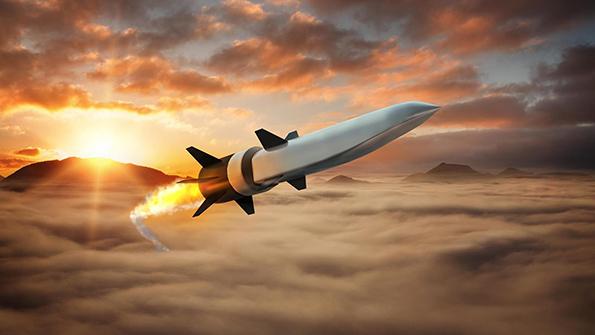
A demonstrator for a hypersonic missile flew faster than Mach 5 for 300 nm above 60,000 ft. over a Western training range in mid-September, finally breaking a nine-year drought of successful testing for an air-launched, U.S.-made hypersonic vehicle.
- Lockheed Martin HAWC design close behind
- U.S. hypersonic programs face new scrutiny
In the end, a Raytheon cruiser powered by a Northrop Grumman scramjet engine scored the long-awaited landmark test by DARPA’s Hypersonic Air-breathing Weapon Concept (HAWC) program, marking a competitive coup for the missile company.
DARPA originally selected only Lockheed Martin in 2017 to participate in the HAWC program. But the Raytheon/Northrop team got another shot a year later, when DARPA decided to also fund their competing HAWC demonstrator.
“We finally came to a point where Raytheon was able to put everything together and demonstrate those major objectives that we wanted to accomplish in the mission,” says Andrew Knoedler, DARPA’s HAWC program manager.
The mission included the first U.S. scramjet-powered flight test at hypersonic speed since May 1, 2012, the day the Air Force Research Laboratory (AFRL)/DARPA X-51 experimental vehicle achieved Mach 5.1 and 210 sec. of continuous combustion.
The more recent test provided “very similar” speed and endurance results to that fourth and most successful flight attempt by the Boeing/Aerojet Rocketdyne X-51, Knoedler says.
Although the results appeared similar, DARPA has another objective for the series of HAWC test flights. A decade ago, the X-51 proved that a scramjet engine fueled by a standard military kerosene mixture could achieve hypersonic speed over a mission-relevant distance. For the competing HAWC demonstrators, the goal is instead to show Air Force fighter and bomber crews that a scramjet-powered flight vehicle can be configured with sensors and other equipment necessary to function reliably as a cruise missile.
The HAWC flight tests also are scrutinizing the maturity and performance of the scramjet, outer-mold line of the cruiser, inner-mold line of the engine inlet and the compression surfaces and combustor inside the scramjet, Knoedler says.
Raytheon might have completed the first successful HAWC flight test, but Lockheed may not be far behind. Lockheed has already completed a previously undisclosed flight test that demonstrated a separation from the launch aircraft and ignition of the booster stage, Knoedler says. As planned, the Lockheed test did not activate the Aerojet Rocketdyne scramjet engine.
DARPA now plans to stage two more flight tests of the Raytheon/Northrop vehicle and three hypersonic tests of the Lockheed/Aerojet demonstrator. The agency hopes to complete the hypersonic tests as quickly as possible in order to feed performance data to the newly launched Southern Cross Integrated Flight Research Experiment (SciFire) program.
Boeing, Lockheed and Raytheon received contracts in September to begin designing SciFire missiles for the U.S. Air Force and the Royal Australian Air Force. A flight test is scheduled in the third quarter of fiscal 2024. A follow-on program by the Air Force aims to deliver operational missiles by fiscal 2027 under the Hypersonic Attack Cruise Missile program.
But first the hypersonic programs will face a new round of scrutiny under the Biden administration. Air Force Secretary Frank Kendall said on Sept. 20 that he intends to reassess the operational relevance of hypersonic weapons, including the Lockheed AGM-183A rocket-boosted glider. “I think it’s still somewhat of a question mark,” Kendall said.
A Mach 5 missile, for example, can hit a target 1,700 mi. away in 30 min., but a targeted missile launcher can relocate during that period. Targeting such a missile also would require a vast infrastructure for sensing threats and assigning them to eligible weapons. Both of those issues were raised by a Long-Range Strike webinar hosted by Mitre Corp. on Sept. 15.
But Jeff Babione, the head of Lockheed’s Skunk Works, remains confident that hypersonic weapons will prevail in Kendall’s operational assessment. Speaking at a DefenseOne virtual event on Sept. 28, Babione suggested that Kendall may simply not have had time to review the assessments already available.
“He’s a smart man. He wants to see the data,” Babione says. “We just haven’t had a chance to show him the operational analysis that shows where these things are useful. What I know about their endgame effectivity is [that it is] exceptional.”






Comments
Bernard Biales